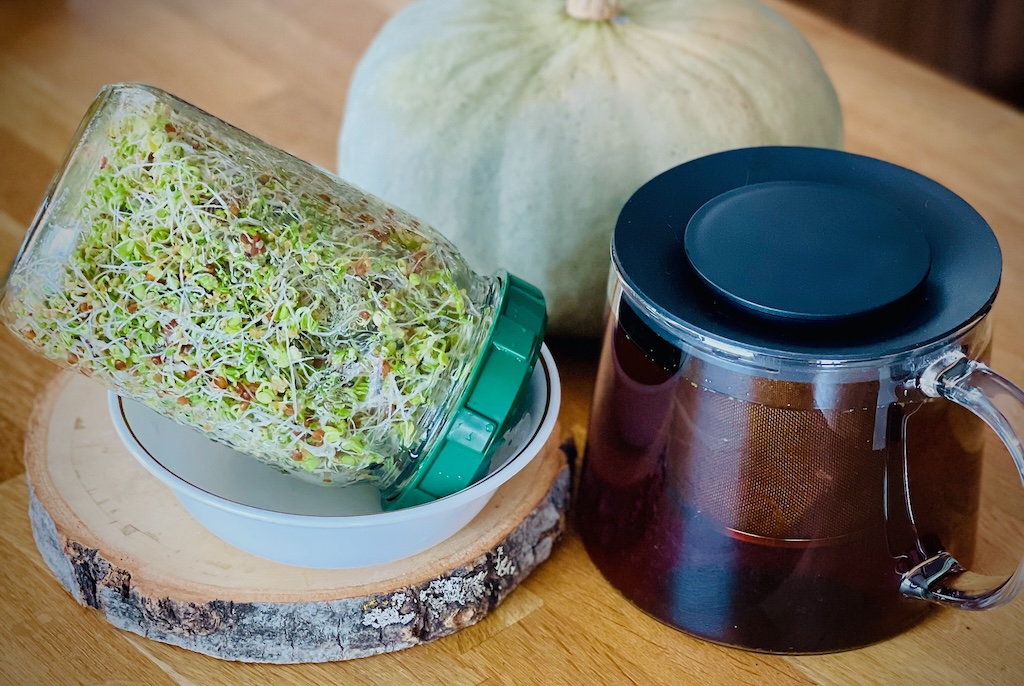Your mama was right, you need your greens. Some of you do get a free pass because your doctor advises against greens due to medical conditions, or potential interactions with drugs. For the rest of us, we need regular portions of nutrient-dense, disease fighting, system regulating greens. Let’s explore a few ways we can get enough greens when gardens covered in snow, and it’s freezing outside.
It is such a shame to spend money on tender greens, then take them home, and find out that they froze on the way back from the store. Many Canadians know exactly what I mean. After many years of disappointment, I now use a variety of options for winter greens, including baby greens that I can bring home on the balmier days. Here is a short list of greens that I like in the winter.

Tough Leaves like kale, rapini, and collard greens. Stir-fry or steam these hardy greens. Make kale into some of the best chips. Black kale is more tender and can be used in salads. Collards, cabbage, rapini and romaine lettuce can often make it home, no problem.

Sprouts There are many different types of sprouts to pick up at the grocery store. I love sunflower sprouts. After a few years of experimenting, I have come up with an excellent way to produce sprouts at home each week. There is nothing better than a few sprouts to round out any meal, including a fresh croissant and cheese. The best! Find my countertop sprouts method here.

Nutritive Infusions such as dandelion, nettle, red clover, and raspberry leaf. Buy nutritive herbs by the pound and make a litre or quart of infusion a few times a week.
Susun Weed has an excellent method for making a strong infusion. She suggests using 1 cup of dried herbs placed in a quart jar, and pouring boiling water over the herbs, and put on the lid to the quart jar. Let it sit overnight and drink throughout the next day. When you do this, you create a mineral and phytochemical rich infusion. If you find this a bit too strong, play with the ratios and amounts of herbs you use, and if necessary, add flavourful herbs such as fennel, peppermint, or spearmint. I prefer to use around 4 tablespoons of dried nutritive herbs in a quart of water and I drink this infusion regularly. It’s best to allow a long infusion time, anywhere between 4 to 10 hours. If your home is extra warm, you will want to refrigerate the infusion after infusing. My home is a bit cool, especially in the winter, so I can leave the infusion on the counter.
Nutritive herbal infusions are very beneficial in strengthening the whole body. There is even a saying amongst herbal practitioners, “when in doubt, try nettles.” It often makes a difference in improving health, even if the condition is not that well understood. It’s that good! Create a sustainable practice that you enjoy and that you will continue to drink. Listen to your body, use your senses, and choose what works for you. Stay curious and research what others say about this healthy practice. You will be rewarded. Nettles can also be powdered or cooked and used in smoothies and food.
Hearty Herbs. Bunches of herbs are some of the healthiest foods in the grocery store. Buy fresh parsley or cilantro regularly and add liberal amounts of them to foods.
Yes, it would be bleak to only rely on dried herbs, but I consider herbs, even if they are dried, to be a very small source of potent anti-inflammatory “greens.” Actually, think of any herb or spice in your cupboard as a potent anti-inflammatory. Flavour isn’t the only reason there is such a long history of use of herbs and spices in cooking. They protect us too. Herbs preserved in salt are also a source of greens, but obviously they cannot be the only source without over doing it on salt.
Seaweed. Add little snippets of seaweed added to all kinds of foods, such as pizza, salad, soup, rice or other grains. Seaweed is salty and mineral in flavour. It is interesting when included in many types of food. Seems a bit wild, but I like to add bits of Laver, a wild Atlantic Nori, to a trail mix or I will eat it like chips. Add Alaria, a wild Atlantic Wakame, to salads or soups. Dulse is nice on pizza, mixed with salsa, or in sandwiches. Kelp chips are fun. Add kelp to rice, beans, or soups.

Frozen Spinach. Pick-up spinach that is frozen into little individually portioned “spinach pucks” at your local grocery store. I quickly thaw out and use these pucks in dishes. I add them to fried shallots and eggs to make a nice plate of green eggs in the morning.

Lactofermented Cabbage and Other Lactofermented Vegetables. In small portions, lactofermented vegetables will aid digestion by adding beneficial bacteria to your digestive system. It’s tasty and adds a little something extra to a meal. If you are looking for a great book on fermentation, check out Wild Fermentation by Sandor Ellix Katz. This is an awesome, well researched, and easy to follow book on fermentation.
Greens powder. I will take them from time to time. Many people claim to have good results with green powders, especially when they take them on a regular basis.
This is an updated version of the blog post January 12, 2011, Getting Greens in the Dead of Winter.
Tammy Schmidt, Montreal

